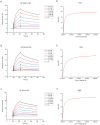Molecular characterization of the monoclonal antibodies composing ZMAb: a protective cocktail against Ebola virus
- PMID: 25375093
- PMCID: PMC5381473
- DOI: 10.1038/srep06881
Molecular characterization of the monoclonal antibodies composing ZMAb: a protective cocktail against Ebola virus
Abstract
Ebola virus (EBOV) causes severe viral hemorrhagic fever in humans and non-human primates, with a case fatality rate of up to 88% in human outbreaks. Over the past 3 years, monoclonal antibody (mAb) cocktails have demonstrated high efficacy as treatments against EBOV infection. One such cocktail is ZMAb, which consists of three mouse antibodies, 1H3, 2G4, and 4G7. Here, we present the epitope binding properties of mAbs 1H3, 2G4, and 4G7. We showed that these antibodies have different variable region sequences, suggesting that the individual mAbs are not clonally related. All three antibodies were found to neutralize EBOV variant Mayinga. Additionally, 2G4 and 4G7 were shown to cross-inhibit each other in vitro and select for an escape mutation at the same position on the EBOV glycoprotein (GP), at amino acid 508. 1H3 selects an escape mutant at amino acid 273 on EBOV GP. Surface plasmon resonance studies showed that all three antibodies have dissociation constants on the order of 10(-7). In combination with previous studies evaluating the binding sites of other protective antibodies, our results suggest that antibodies targeting the GP1-GP2 interface and the glycan cap are often selected as efficacious antibodies for post-exposure interventions against EBOV.
Conflict of interest statement
Her Majesty the Queen in right of Canada holds a patent on the monoclonal antibodies 2G4, 4G7, and 1H3, PCT/CA2009/000070, “Monoclonal antibodies for Ebola and Marburg viruses.” The authors declare that they have no competing interests.
Figures





Similar articles
-
Mechanism of Binding to Ebola Virus Glycoprotein by the ZMapp, ZMAb, and MB-003 Cocktail Antibodies.J Virol. 2015 Nov;89(21):10982-92. doi: 10.1128/JVI.01490-15. Epub 2015 Aug 26. J Virol. 2015. PMID: 26311869 Free PMC article.
-
Antibody-Mediated Protective Mechanisms Induced by a Trivalent Parainfluenza Virus-Vectored Ebolavirus Vaccine.J Virol. 2019 Feb 5;93(4):e01845-18. doi: 10.1128/JVI.01845-18. Print 2019 Feb 15. J Virol. 2019. PMID: 30518655 Free PMC article.
-
Structures of protective antibodies reveal sites of vulnerability on Ebola virus.Proc Natl Acad Sci U S A. 2014 Dec 2;111(48):17182-7. doi: 10.1073/pnas.1414164111. Epub 2014 Nov 17. Proc Natl Acad Sci U S A. 2014. PMID: 25404321 Free PMC article.
-
[Research progress on ebola virus glycoprotein].Bing Du Xue Bao. 2013 Mar;29(2):233-7. Bing Du Xue Bao. 2013. PMID: 23757858 Review. Chinese.
-
The Roles of Ebola Virus Soluble Glycoprotein in Replication, Pathogenesis, and Countermeasure Development.Viruses. 2019 Oct 31;11(11):999. doi: 10.3390/v11110999. Viruses. 2019. PMID: 31683550 Free PMC article. Review.
Cited by
-
Antibody Treatment of Ebola and Sudan Virus Infection via a Uniquely Exposed Epitope within the Glycoprotein Receptor-Binding Site.Cell Rep. 2016 May 17;15(7):1514-1526. doi: 10.1016/j.celrep.2016.04.026. Epub 2016 May 5. Cell Rep. 2016. PMID: 27160900 Free PMC article.
-
Ebolavirus comparative genomics.FEMS Microbiol Rev. 2015 Sep;39(5):764-78. doi: 10.1093/femsre/fuv031. Epub 2015 Jul 14. FEMS Microbiol Rev. 2015. PMID: 26175035 Free PMC article. Review.
-
Structure of the Inmazeb cocktail and resistance to Ebola virus escape.Cell Host Microbe. 2023 Feb 8;31(2):260-272.e7. doi: 10.1016/j.chom.2023.01.002. Epub 2023 Jan 27. Cell Host Microbe. 2023. PMID: 36708708 Free PMC article.
-
Mechanistic and Fc requirements for inhibition of Sudan virus entry and in vivo protection by a synthetic antibody.Immunol Lett. 2017 Oct;190:289-295. doi: 10.1016/j.imlet.2017.09.002. Epub 2017 Sep 8. Immunol Lett. 2017. PMID: 28890093 Free PMC article.
-
Unveiling a Drift Resistant Cryptotope within Marburgvirus Nucleoprotein Recognized by Llama Single-Domain Antibodies.Front Immunol. 2017 Oct 2;8:1234. doi: 10.3389/fimmu.2017.01234. eCollection 2017. Front Immunol. 2017. PMID: 29038656 Free PMC article.
References
-
- Weissenhorn W., Carfí A., Lee K. H., Skehel J. J. & Wiley D. C. Crystal structure of the Ebola virus membrane fusion subunit, GP2, from the envelope glycoprotein ectodomain. Mol. Cell 2, 605–16 (1998). - PubMed
Publication types
MeSH terms
Substances
LinkOut - more resources
Full Text Sources
Other Literature Sources
Molecular Biology Databases
Miscellaneous

